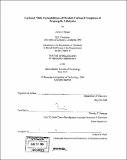| dc.contributor.advisor | Timothy F. Jamison. | en_US |
| dc.contributor.author | Skaggs, Aaron J. (Aaron Jeremy), 1976- | en_US |
| dc.contributor.other | Massachusetts Institute of Technology. Dept. of Chemistry. | en_US |
| dc.date.accessioned | 2005-06-02T18:28:04Z | |
| dc.date.available | 2005-06-02T18:28:04Z | |
| dc.date.copyright | 2004 | en_US |
| dc.date.issued | 2004 | en_US |
| dc.identifier.uri | http://hdl.handle.net/1721.1/17741 | |
| dc.description | Thesis (Ph. D.)--Massachusetts Institute of Technology, Dept. of Chemistry, 2004. | en_US |
| dc.description | Vita. | en_US |
| dc.description | Includes bibliographical references. | en_US |
| dc.description.abstract | The intermolecular, three-component carbonyl ylide cycloaddition of a diazo compound, aldehyde, and carbon-carbon multiple bond is a powerful method to construct five-membered oxygen heterocycles. An adjacent dicobalt hexacarbonyl cluster permits the expansion of the scope of this process to include propargylic aldehydes (2-alkynals). The cluster not only increases the rate of reaction for this class of aldehydes, but also leads to a complete reversal in the diastereoselectivity compared to related methods and favors the exclusive formation of a 2,5- cis relationship in the products. Furthermore, the use of trimethylsilyldiazomethane (TMSD) as the carbene source allows coupling with a variety of dipolarophiles in moderate to high yields with good selectivity. Interaction of the (,il2-alkyne)Co2(CO)6 fragment with the neighboring positive charge of the 1,3-dipole is postulated to be a cause for the enhanced reactivity and selectivity. The choice of carbene transfer catalyst has no effect on either diastereocontrol or enantioselection, which suggests a mechanism involving a free ylide. While the Co2(CO)6 fragment can be removed to give the free alkyne in high, a catalytic amount of cobalt in the cycloaddition is modestly effective. Exchange of one or two carbonyls of the cobalt cluster by achiral and chiral phosphorous ligands results in dramatically lowered reaction efficiency. X-ray crystal structures of two of these substituted cobalt clusters are presented. -- [Image] | en_US |
| dc.description.statementofresponsibility | by Aaron J. Skaggs. | en_US |
| dc.format.extent | 140 leaves | en_US |
| dc.format.extent | 3517363 bytes | |
| dc.format.extent | 3517173 bytes | |
| dc.format.mimetype | application/pdf | |
| dc.format.mimetype | application/pdf | |
| dc.language.iso | eng | en_US |
| dc.publisher | Massachusetts Institute of Technology | en_US |
| dc.rights | M.I.T. theses are protected by copyright. They may be viewed from this source for any purpose, but reproduction or distribution in any format is prohibited without written permission. See provided URL for inquiries about permission. | en_US |
| dc.rights.uri | http://dspace.mit.edu/handle/1721.1/7582 | |
| dc.subject | Chemistry. | en_US |
| dc.title | Carbonyl ylide cycloadditions of dicobalt carbonyl complexes of propargylic aldehydes | en_US |
| dc.type | Thesis | en_US |
| dc.description.degree | Ph.D. | en_US |
| dc.contributor.department | Massachusetts Institute of Technology. Department of Chemistry | |
| dc.identifier.oclc | 56481405 | en_US |
